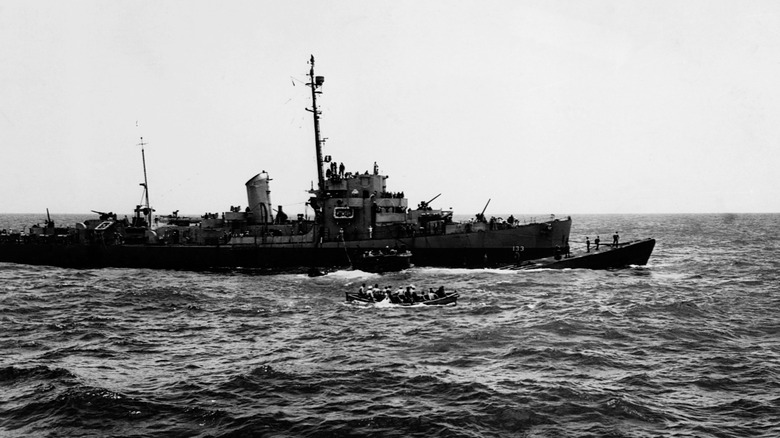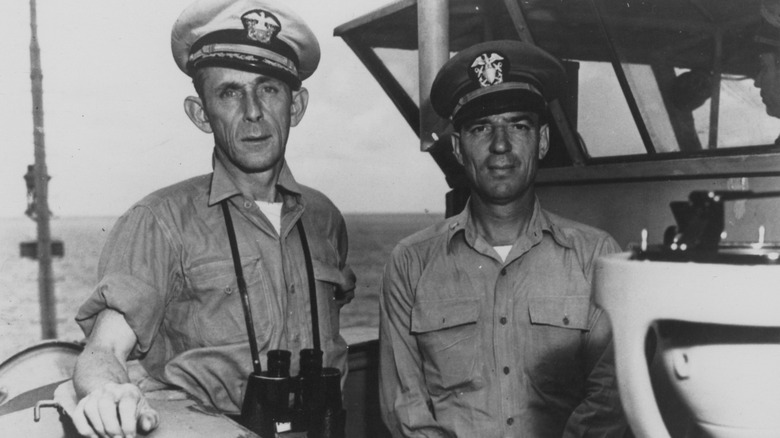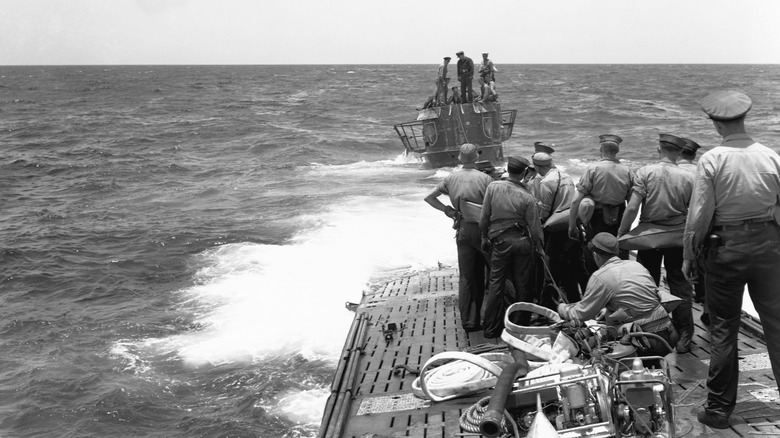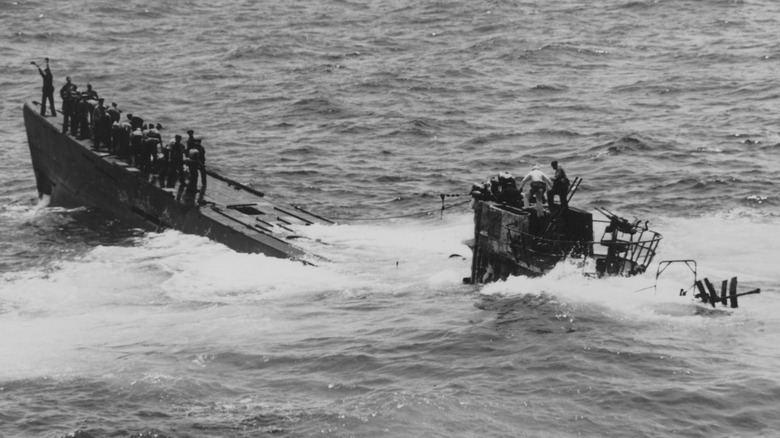
Historical/Getty Images
The Kriegsmarine and its U-boats famously caused unprecedented damage and disruption to Allied shipping during the early years of World War II. Their well-guided torpedoes ripped holes in the sides of merchant ships, starting fires and explosions that would often sink the ships completely and leave them as shipwrecks on the ocean floor. As for the crews, the survivors were few.
That’s why it was so important for the Allies to learn about the U-boats and their technology, and train soldiers to deal with them as efficiently as possible. They tried forming convoys of merchant ships escorted by escort carriers and destroyers—this helped when it was just one U-boat against a convoy of up to 200 ships. But the Germans countered by forming Wolfpacks—groups of more than 40 U-boats that could wreak havoc even on the largest convoys.
In desperate need of a new tactic, the U.S. Navy created anti-submarine escort ships and had them work in units called Hunter-Killer Task Groups. Made up of a lead anti-submarine escort carrier and multiple destroyer escorts, these groups roamed the water hunting for U-boats. One special Hunter-Killer Task Group even managed to capture a submarine—the U-505.
The birth of Hunter-Killer Task Group 22.3

Museum Of Science And Industry, Chicago/Getty Images
The U-505 was launched on May 24, 1941, and completed 12 patrols before it was eventually captured. Over its three years of service, it had four commanders — one of whom died by suicide during heavy depth charging in 1943. It mostly operated independently but it briefly joined a Wolfpack at the beginning of 1944.
In May of that year in the U.S., Hunter-Killer Task Group 22.3 was formed. It was led by the anti-submarine escort carrier USS Guadalcanal, named for the famous Guadalcanal campaign carried out by the United States Marines from August 1942 to February 1943. Supporting the USS Guadalcanal were five destroyer escorts, which were smaller, more maneuverable boats equipped with radar, guns, and torpedoes for hunting U-boats.
Captain Daniel V. Gallery was the commander of the Guadalcanal and the man who proposed capturing a U-boat. When he returned to the U.S. from a patrol in April 1944, he ordered the Task Group to start figuring out strategies to capture a U-boat, along with hoarding exercises and methods to tow it back to the U.S. In May, they set out with permission to make those plans a reality.
The hunt

Historical/Getty Images
Task Group 22.3’s hunting efforts were aided by a top-secret intelligence operation dubbed F-21. It was a U-boat tracking room that sent daily briefings to the Task Group to help them locate the target. In the beginning, it was slow work, but just as Gallery was about to turn back to refuel, one of the destroyer escorts reported a sonar contact.
They began to attack immediately, using hedgehogs and depth charges packed with the United States’ new Torpex explosives. Eventually, the U-505 was forced to surface but, faced with capture, its crew quickly carried out preparations to sink the submarine. With so much secret tech and information on board, it was much better for everything to be destroyed rather than fall into the hands of the Allies.
The boarding party from Task Group 22.3 had other plans, though. While some sailors began picking up survivors from 505, a group of nine specially trained soldiers was tasked with boarding the sinking sub and gathering that all-important information.
Inside, they were faced with bombs called scuttle charges and open pipes letting water rush into the boat. There were, at least, no soldiers left on board except the one casualty of the capture operation which allowed the party to work quicker. They covered the open pipe and pulled the wires on the scuttle charges.
The journey home

Museum Of Science And Industry, Chicago/Getty Images
The boarding party was able to retrieve important charts and codebooks but that was far from the only dangerous part of the mission. Gallery now wanted to tow the boat back to U.S. shores—even though it was quickly sinking.
With over 2,500 nautical miles to cover, Commander Earl Trosino spent hours below decks, often underwater, crawling into dangerous parts of the sub and closing valves to keep it afloat. Gallery later said it was the Commander’s «uncanny instinct for finding the right valves, and his total disregard for his own safety» that made the operation successful.
For the capture to be useful, it was imperative that the Germans assumed the 505 had sunk. This meant that the 58 members of the 505’s crew had to be isolated from other POWs and prevented from sending letters—conditions that actually broke the Third Geneva Convention. This meant America was technically committing a war crime to keep the capture of this sub a secret.
The crew attempted multiple times to get word of their capture out but to no avail. Meanwhile, the information gained from the sub contributed to the Allies gaining the upper hand against the U-boats, and eventually, on May 4, 1945, Germany ordered its U-boats to stand down. The U.S. Navy made its capture of the 505 public just two days later, and the legendary submarine went on tour to help raise funds for the fight against the Japanese in the Pacific.
You can still visit the 505 today
Once the U.S. Navy had no more use for the U-505, they planned to use her for target practice. It was Daniel V. Gallery, the commander who captured the sub, who stopped this from happening. He was a Chicago native, and together with the Chicago Museum of Science and Industry and the city’s residents, he raised the $250,000 needed to repair the sub and move it to the museum.
The move was not easy. It had to be towed 3,000 miles from New Hampshire to Lake Michigan and transported 800 feet over land from the lake to the museum. When it was finally in place, the U-505 was dedicated as a war memorial and became a permanent exhibit at the Chicago Museum of Science and Industry—and yes, it’s still there today! In fact, it’s now a National Historic Landmark and the only Type IX-C U-boat left in existence.